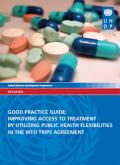Publications - Released in 2010
Over the past ten years, there has been a remarkable and virtually unprecedented global scaleup of a life-saving medical technology: antiretroviral therapy for people with advanced HIV infection. This therapy not only prolongs life for most patients, it keeps people healthy enough to work, to continue their lives in families and as parents, and to contribute to their communities and countries. We now know that antiretroviral therapy also lowers the amount of HIV in the bloodstream, thus making people less infectious and contributing to HIV prevention goals as well.
The successes of the past ten years are directly linked to the drastic fall in the price of these drugs. The cost of first generation antiretrovirals has decreased from over ten thousand US dollars to as low as 67 dollars per person per year. This amazing reduction has been achieved largely thanks to competition from generic manufacturers, which, for millions of people worldwide, has been the difference between life and death. Such competition has in large part been made possible by countries' utilization of the public health flexibilities in the World Trade Organization's TRIPS Agreement.
The Good Practice Guide analyses each of the public health flexibilities in the TRIPS Agreement
and provides examples where and how have they been used by national governments. The Guide
also provides some examples on the effect of adopting intellectual property protection measures,
which exceed the minimum requirements of TRIPS and which are often introduced through bilateral trade instruments.
Downloads
Organizations
- United Nations Development Programme (UNDP)






